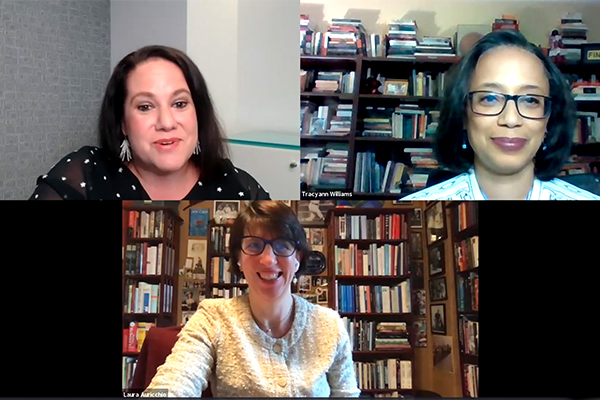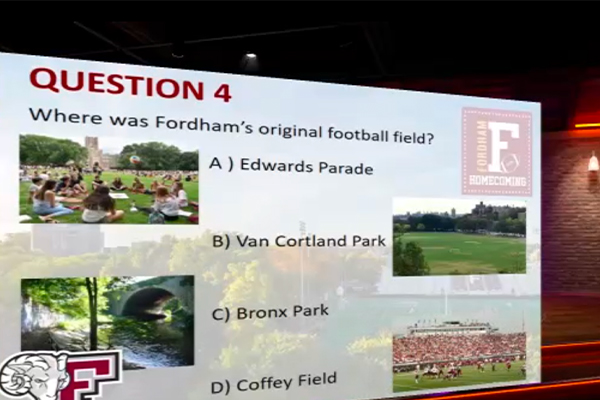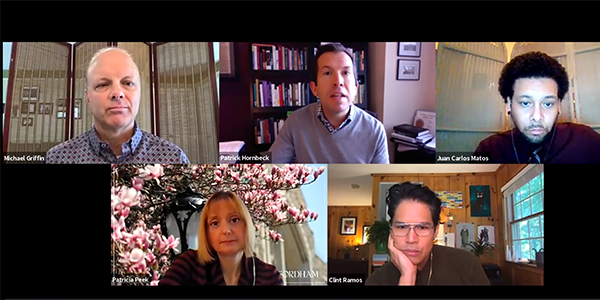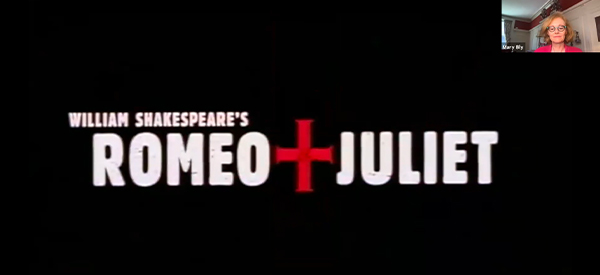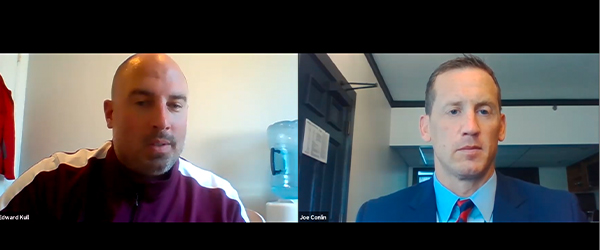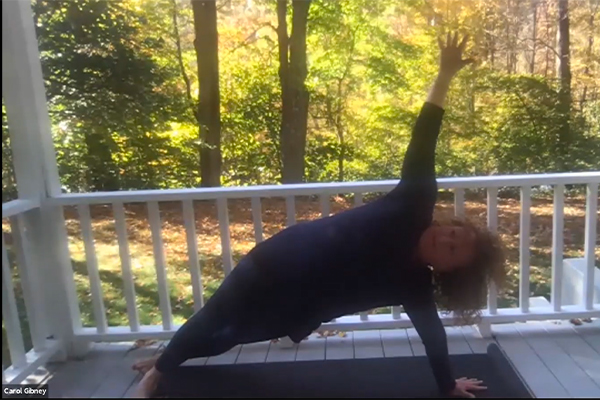Fordham can’t wait for the Class of 2028!
On March 15, the admission team shared decisions with applicants, officially inviting future Rams to be part of the Fordham family.
Accepted students were drawn from the nearly 44,000 candidates who applied for Fordham’s full-time undergraduate programs in the 2023-2024 application cycle. With applicants hailing from across the country and around the world, Fordham has one of the largest applicant pools in the nation for private colleges and universities, ranking as high as 15th for the number of applications received in recent years.
“Fordham attracts talented students with a diversity of interests and experiences. Our applicants are leaders, athletes, writers, researchers, advocates, performers, and artists,” said Patricia Peek, dean of undergraduate admission. “They come from a variety of backgrounds and locations. We have a very qualified pool of applicants who would be successful at Fordham.”
A Nationwide Draw
Fordham received applications from students in all 50 states; Washington, D.C.; and Puerto Rico, and has continued to expand its presence beyond the Northeast. While New York still comprised the highest number—more than 13,000 applications this year, including 1,800+ from the Bronx and 2,200+ from Manhattan—many applicants hail from New Jersey, California, Massachusetts, Pennsylvania, Florida, and Texas. Peek said Fordham has seen increased growth in Puerto Rico, Illinois, and Louisiana over the past few cycles.
Students applied from a diverse group of more than 9,000 high schools, including public, private, and Jesuit, to be a part of this year’s class, Peek said.
Global Growth
With students applying from more than 150 countries, the University has seen an 8% increase in its number of international applicants. India, Vietnam, Brazil, Ghana, and Venezuela are a few of the countries where interest in Fordham continues to grow.
Attracting students from around the world who can enrich and be enriched by the Fordham community has been a priority for the University, Peek said.
“The diverse mix of international and domestic students creates a rich, vibrant campus environment for everyone. Not only are Fordham scholars living and learning in the greatest city in the world—they’re also benefitting from a wealth of perspectives and experiences.”
Talented Applicant Pool
Fordham received applications for nearly every one of its 70+ majors, ranging from biological sciences to journalism, from finance to theatre. About 3,500 students applied as undecided, which allows them to explore their varied interests and develop new skills.
On average, applicants have a high school grade point average of 3.57, (90+ or A/A-). Peek said that many students have taken challenging courses, such as Advanced Placement, International Baccalaureate, and honors classes, which the admission team considers as part of its holistic application review. Fordham is test-optional, meaning that students are considered for admission, scholarships, and honors programs whether or not they submit scores. Peek said that academic performance and preparation in high school are always reviewed in the context of the student’s experience and are a core element of the application review.
Greater Interest in Business
While Fordham College at Rose Hill received the most applications overall, with more than 22,000 this year, the Gabelli School of Business programs at Rose Hill and Lincoln Center continued to see an increase in applications, as did Fordham College at Lincoln Center.
Supporting Students Amidst FAFSA Delays
While this year’s financial aid application process has been complicated by the delayed FAFSA, Brian Ghanoo, associate vice president for student financial services, said the University is committed to helping students and their families through the process.
Because the University uses another financial aid form called the CSS Profile in addition to the FAFSA, Ghanoo said that they’ve been able to provide families with a preliminary financial aid offer.
“Fordham is committed to upholding the financial aid offer that you’ve received,” he shared with families. “It may go up, but it should not go down, as long as all of the data on the FAFSA is consistent with the information you provided on the [CSS] Profile.”
Ghanoo noted that the financial aid offer that students receive for the first year is renewable for the remaining three years, as long as students meet the renewal criteria and complete the FAFSA.
Peek said that both the undergraduate admission and financial aid offices “believe in care of the whole person and work with families and their circumstances individually.” The offices often work together to host joint virtual sessions to help students throughout each stage of the process—from application to admission to enrollment.
“Both offices interact with students on campus and virtually, and want to help make what is often a stressful process as easy as possible,” she said.
Class of 2028 and Beyond: Looking Ahead to Future Rams
Reviewing applications for the incoming class is just one part of the admission team’s work. Counselors are also actively engaging with prospective high school juniors and sophomores—meeting with them in their schools, at college fairs, or on Fordham’s campuses— as they begin the college search process.
Students interested in learning more about Fordham are invited to visit campus and see what student life is like. There are a variety of opportunities, including tours, information sessions, and fall open houses. Fordham also offers recently expanded pre-college summer programs for high school students interested in challenging themselves and gaining college experience.
“We’re excited to welcome the Class of 2028 and all our future classes of Rams,” said Peek.
Learn more about admissions opportunities and how to apply to Fordham.
]]>“I’m meeting people who I would have never been able to meet in other ways from both campuses, and I’m watching the things that I see every day coming to life in a virtual world,” said Zoe Demacopoulos, a senior at Fordham College at Lincoln Center who helped build the virtual entrance of Lowenstein Center. “It’s nice to know that I can still build community and hang out with people on a semi-regular basis [during the pandemic].”
The goal of the project is to engage students, especially the first-year class, during a year that has made social activity more difficult than usual, said Patricia Peek, Ph.D., dean of undergraduate admission.
A Way to Connect
“When we learned last summer that other colleges had these fun images, we thought that it might be a great way to create a virtual Fordham while giving new students a way to engage with each other in a virtual space,” Peek said.
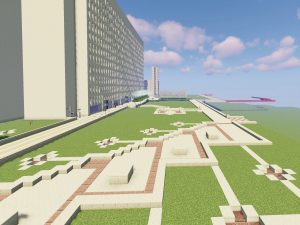
After months of planning, RamCraft began in earnest this spring. The project is a collaborative effort among student volunteers and the Department of Communication and Media Studies, with the support of Fordham IT, Peter A. Stace, Ph.D., senior vice president for enrollment and strategy, and Eva Badowska, Ph.D., dean of the faculty of arts and sciences and associate vice president for arts and sciences.
On Wednesday evenings, the student design team logs onto Minecraft and works on Fordham’s virtual Lincoln Center campus. (Design of the Rose Hill campus will begin this summer.) They communicate through Discord, a free chat service that is popular among gaming communities, where they can hear each other’s voices and watch each other stack virtual blocks in real time.
The underlying purpose of these meetings is to create an inclusive, supportive community where students can connect through a fun activity and escape from the stress of the pandemic, said the faculty project manager, Christopher Vicari.
“I’ll throw on lo-fi hip-hop beats. We’ll vibe, chill, and just build and talk,” said Vicari, an educational technologist in the communication and media studies department.
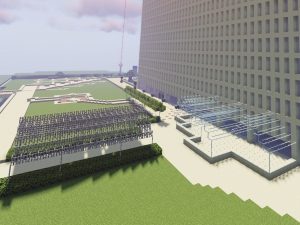
There are 10 to 15 students working on RamCraft, ranging from beginners to longtime players who were introduced to the game when they were children. Among them is Demacopoulos, a senior at Fordham College at Lincoln Center who plans to start at the Graduate School of Education in the fall on the 5-year track. The aspiring high school English teacher has played Minecraft since the game was released in 2011. It used to be a fun way for her, as a New York resident, to bond with her long-distance childhood best friend from Massachusetts for nearly seven years. Now the game is serving a new purpose.
Demacopoulos and her classmates have been “building” since March, selecting block styles and ratios based on blueprints from Fordham Facilities Management, images from Google Earth, and photos of campus shot on their smartphones, said Vicari.
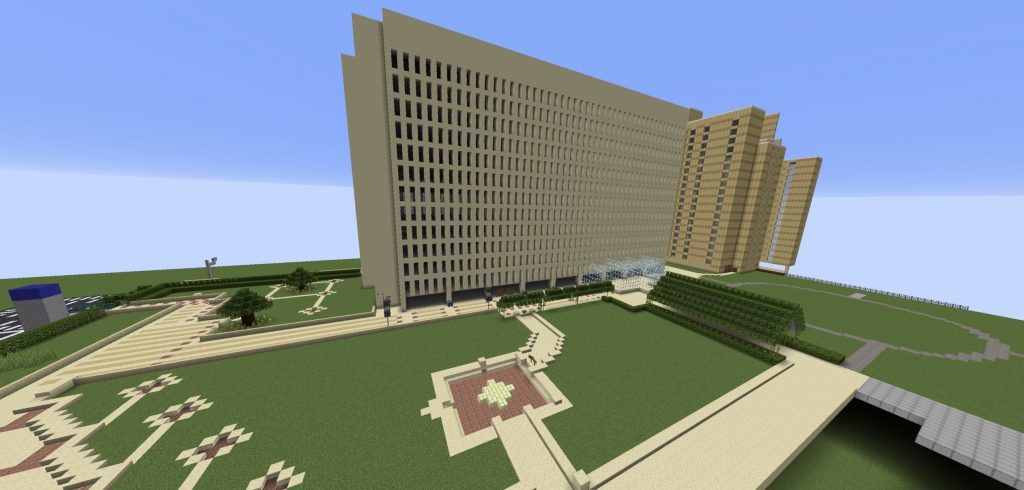
Striving for Precision
“Some students have gone to campus to take pictures of different elements of the architecture and floor patterns so we know how to match it as one-to-one as possible,” said Vicari, who has also visited campus to take photos. “Our goal is to be a little OCD and to try and get it as accurately as we can. But that’s where we’ll most likely have the most fun, too, because we get to flavor things individually.”
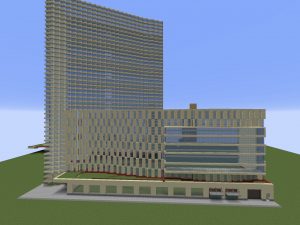
The RamCraft team has finished building the exterior of the Lowenstein Center, McMahon Hall, and Columbus Avenue. Next up are McKeon Hall and the Law School.
The team is deliberating on how far away the virtual Lincoln Center campus should be from the Rose Hill campus. They have yet to complete the most difficult tasks—the interiors of each building, including the Lowenstein lobby. The overall project won’t be finished for at least two more years, Vicari estimated. But so far, the project has accomplished something more poignant during a difficult year.
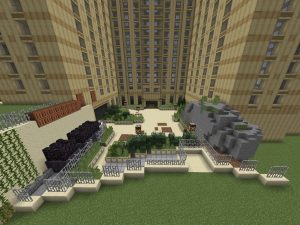
“One of the big issues of the pandemic was finding a social circle or a group of friends in a university,” said Preeti Grewal, a first-year student at Fordham College at Lincoln Center who is studying remotely from Queens. “You’re starting off in a brand new place, and you don’t really know anyone. But I’ve been able to play Minecraft, study, and manage to make friends.”
At the end of her four years at Fordham, Grewal will also have a special project in her portfolio.
“There were a lot of murals in my old high school. All the names would be on the bottom left with ‘Class of 1993’ or something,” said Grewal, a political science student on the pre-law track. “That’s going to be us, but on Minecraft.”
Students interested in participating in RamCraft can contact Vicari at [email protected].
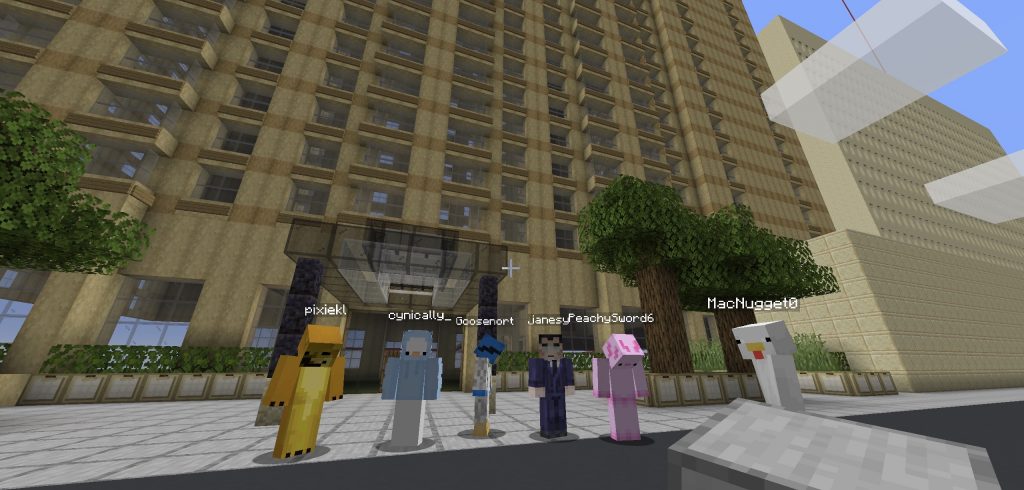
From Oct. 1 to 4, hundreds of alumni, family, and friends—from as far as Germany—tuned in for an expanded series of virtual events that drew on some of the best-loved Homecoming traditions, like the 5K Ram Run and tailgate parties, and included a “pub” trivia competition, updates on academic and student life amid COVID-19, and a tribute to the 50th anniversary of a Fordham football milestone.
In addition to joining panels and discussions sponsored by the Office of Alumni Relations, Fordham graduates took to social media, where thousands viewed Homecoming Instagram stories and tweets shared via the @fordhamalumni accounts, and others used the #FordhamHomecoming20 hashtag to post their own messages, including pictures of pets and kids decked out in Fordham gear.
A Forum for FCLC
Things kicked off on Thursday evening with a panel discussion featuring two relative newcomers to the Fordham College at Lincoln Center community: Laura Auricchio, Ph.D., who became dean of the college in August 2019, and Tracyann Williams, Ph.D., who joined FCLC as assistant dean for student support and success last February.
Fordham University Alumni Association Advisory Board member Samara Finn Holland, FCLC ’03, moderated the discussion, during which the deans shared their observations about FCLC students.
“They are an amazing bunch of people,” Auricchio said. “These are students who are not only intelligent and motivated, but they’re really just decent, kind, wonderful human beings.” She recalled several instances of students greeting her when they saw her around the city.
Auricchio noted that political science, economics, and psychology are the three most popular majors among current FCLC students, and the fashion studies minor is growing particularly quickly. She said her office is focused on four areas: connecting to neighbors, enriching courses, enhancing research, and globalizing the curriculum.
Both she and Williams addressed the unique challenges faculty and students face during the pandemic, and Williams noted that part of her job is to help students acknowledge their feelings of disappointment that it’s not a typical academic year, and doing what she can to assist them.
“I am very much interested in always asking students what their needs are and not deciding for them,” she said.
Having worked at other New York City universities before arriving at FCLC, both Auricchio and Williams shared what they think makes Fordham so special.
“I feel as though it’s a unique place where students can come be part of a deeply caring, close-knit community that will support them and help them as they branch out into the city,” Auricchio said. “And to me, it’s just the best of both worlds.”
Pub Trivia at Home
Alumnus Tim Tubridy, FCRH ’99, and his brother, James Tubridy, co-owners of DJs @ Work, hosted a virtual pub trivia session on Friday night. Attendees were invited to answer 10 Fordham-themed questions, either individually or as teams.
The first question of the night delved into a bit of the University’s architectural history: “For what church were the stained-glass windows in the University church intended?” Father McShane delivered both the question and answer (St. Patrick’s Cathedral, when it was located on Mulberry Street), joking that he’d been imagining Jeopardy! theme music playing as he gave contestants time to respond.
Other fun facts unearthed during the Q&A included how many books are housed in the Fordham libraries (more than 2 million), how many acres the Lincoln Center and Rose Hill campuses encompass (8 and 85, respectively), and how many live ram mascots have lived on campus (28).
At the end of the hour-long session, three teams were tied for first place with a whopping 20,000 points each.
A Virtual 5K Ram Run
While the 5K Ram Run is usually held at Rose Hill during Homecoming weekend, this year, alumni were invited to run, jog, or walk a five-kilometer trek of their own and to share photos on social media. Runners were also encouraged to share their finishing times by taking screenshots of their running apps, and the Office of Alumni Relations will be sending prizes to those who submitted their times.
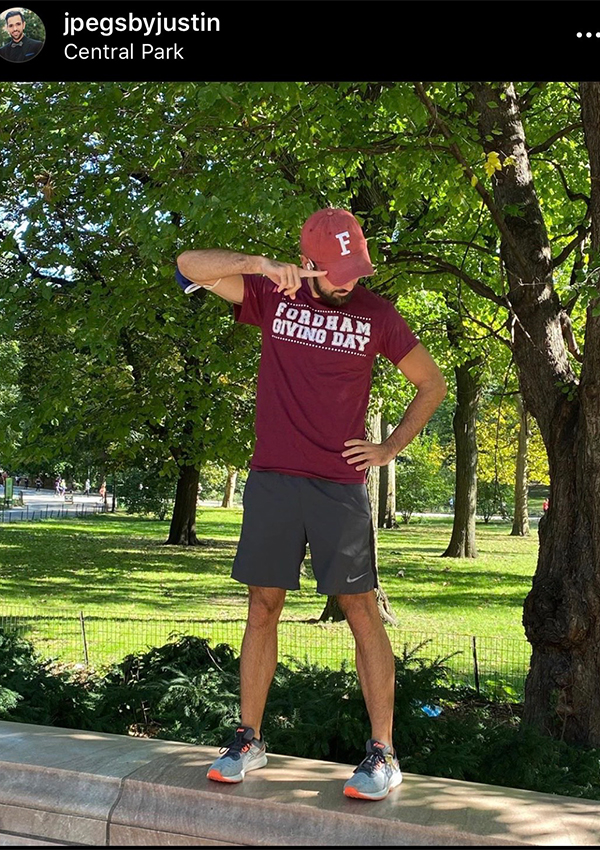
Justin LaCoursiere, FCRH ’12, posted a photo from Central Park and said, “Fordham Homecoming looks a little different this year, but I’m still taking part in some fun [virtual]activities, like the Annual 5K Ram Run.”
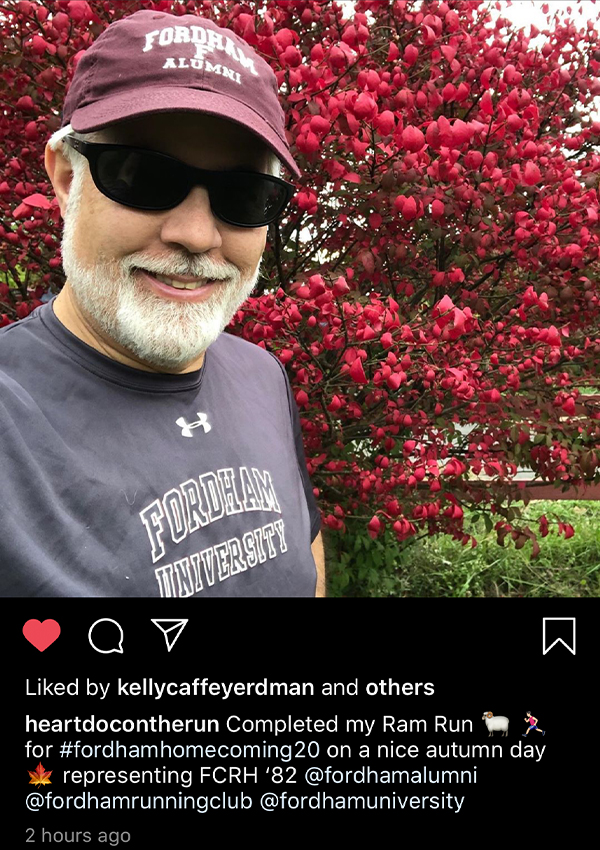
Academic and Student Life Amid the Pandemic
On Saturday morning, a panel of Fordham administrators and faculty discussed the continued uncertainty of COVID-19, its impact on current and prospective Fordham students, and how they’re working to build and strengthen a sense of community under the circumstances. The conversation was moderated by Michael Griffin, associate vice president for alumni relations.
J. Patrick Hornbeck, professor of theology, secretary of the Faculty Senate, and special faculty advisor to the provost for strategic planning, said that soon after Fordham canceled in-person classes and shifted to a virtual format this past March, faculty began planning to avoid such abrupt disruptions for the fall semester. That’s how Fordham developed its flexible hybrid model, which mixes online and in-person learning.
“We would provide opportunities for students to learn and for faculty to teach in several different modalities,” he said. “The idea was, we did not know how things were going to go week-by-week and month-by-month. How could we deliver [a Fordham education]regardless of the way the pandemic would play out?”
During the panel, Patricia Peek, Ph.D., dean of undergraduate admission, said that some of the changes implemented this year, such as virtual guided tours and information sessions, could become permanent to help make Fordham more accessible in the long term.
“I think, even when we’re fully on the ground, we will now always have virtual events because they’re providing so many opportunities and access for students,” she said.
Clint Ramos, head of design and production for Fordham Theatre, noted that the shift “was especially challenging for theatre because our education … is really experiential and a lot of our pedagogy is founded on the ability to gather.” But he said the program has met these challenges head-on, pointing to opportunities for creativity, like a collaborative effort he initiated with theater programs at Princeton, Georgetown, SUNY Purchase, and UMass Amherst. The One Flea Spare Project allows students to virtually attend classes at other universities and collaborate with each other on projects on multiple platforms based on themes in One Flea Spare, a 1995 play by Naomi Wallace set in a plague-ravaged London during the 17th century.
Juan Carlos Matos, assistant vice president for student affairs for diversity and inclusion, spoke about creative ways in which students have tried to maintain a sense of community, whether or not they’re studying on campus. This has included hosting socially distanced outdoor events, such as a “silent disco” on the plaza at Lincoln Center or a musical performance from the Coffey Field bleachers at Rose Hill, for an online audience and a limited number of students in person.
He also said that the pandemic has sharpened students’ focus on social justice, in particular the calls for racial equality that were revitalized this summer.
“Energy that usually is exhausted on other things was nailed into Black Lives Matter in a way where folks who have privilege are just realizing, ‘Hey, these things are happening,’ whereas folks on the margins have always experienced these things.”
Matos said this has spurred action at the University, including an anti-racism plan from Joseph M. McShane, S.J., president of Fordham. And he said the offices of student and multicultural affairs are continuing to offer a variety of programming to keep students engaged. One of the benefits of having virtual or hybrid events is that more students can attend.
“Sometimes it’s difficult for someone to have to choose one campus or the other or we may be offering something on one campus and not the other,” he said. “But virtually, now people can attend in any capacity.”
Shakespeare and Pop Culture
Shakespearean scholar Mary Bly, Ph.D., chair of Fordham’s English department, led a mini-class titled “Pop Romeo & Juliet” on Saturday afternoon. Attendees were encouraged to watch Baz Luhrmann’s 1996 film, Romeo + Juliet, prior to the class, during which Bly delved into the afterlife of the teen duo and their famous star-crossed love.
“Sociologists have made a pretty reasonable case for the argument that Romeo and Juliet actually changed the way we think about love in the Western world, which is very interesting,” Bly said.
Joined by English professor Shoshana Enelow, Bly discussed the idea of cultural capital, looking at how the characters of Romeo and Juliet have survived and how they’ve been transformed in modern adaptations, other films, music, and advertisements. She and Enelow drew parallels to West Side Story, the Beatles, and even a Taylor Swift music video, inviting attendees to write in impressions and examples of their own using Zoom’s Q&A feature.
An Afternoon with Athletics
Fordham sports fans attended two athletics-focused virtual events on Saturday afternoon, including a conversation between Ed Kull, interim director of athletics, and Head Football Coach Joe Conlin.
While the football season, along with those of other fall sports, has been pushed back to spring 2021, winter sports like basketball are planning to get started in late November. Kull highlighted some of the work that has been done to facilities during the pandemic, noting that not having students around for games has allowed several projects to be completed earlier than expected. Among the upgrades that players, coaches, and fans will now find are a new floor for the Frank McLaughlin Family Basketball Court in Rose Hill Gym, renovations to the strength and conditioning and team medicine spaces, and new offices for football staff.
As his team prepares to play in the spring, Conlin discussed the changes to workouts and practices they’ve had to adopt in the time of COVID-19, including health monitoring, socially distanced weight training, and wearing masks under their helmets during practice. Although he and his staff are not allowed to recruit high school players in person this year, they have been talking to recruits over Zoom and reviewing videos to assess their strength and athleticism.
“It’s been challenging at times, but it’s also been a lot of fun,” he said of this new way of doing things on and off the field. “We’ll continue to make it work for as long as we have to.”
Kull noted that out of the 44 seniors across spring sports whose final season was interrupted by cancellations last spring, 19 have decided to come back for a fifth year of eligibility.
Later that afternoon, the Tubridy brothers returned to host a virtual tailgate party that featured a welcome from Father McShane, trivia, performances by the Fordham band from the Coffey Field bleachers, and video updates from departments and groups like the Fordham University Alumni Association, the Center for Community Engaged Learning, and the Mimes and Mummers Alumni Association.
Kull and Conlin also returned for a pre-recorded video from the gravesite of Fordham graduate and NFL coaching legend Vince Lombardi, FCRH ’37, an appropriate lead-in to the tailgate’s final portion: a roundtable discussion with nine players from Fordham’s 1970 football team, which defeated Georgetown 50 years ago during that year’s homecoming game, just weeks after Lombardi’s death.
Moderated by WFUV’s Emmanuel Berbari, a Fordham College at Rose Hill senior, the players recalled the dominant ground game displayed by the Rams in their 39-17 win over the Hoyas, led by Eric Dadd’s 235 rushing yards and three touchdowns. Kevin Sherry, GABELLI ’70, who played offensive tackle, noted that Georgetown had beaten Fordham the previous year, and the Rams were looking for revenge.
Perhaps an even greater motivation for the team was the emotional pregame scene, when Lombardi’s widow, Marie, his brother Joseph, and the remaining members of Fordham’s “Seven Blocks of Granite” offensive line from Lombardi’s playing days honored the Fordham and NFL legend, who had died of colon cancer on September 3. The 1970 season also marked the return of varsity football to Fordham.
Peter “Pino” Carlesimo, FCRH ’71, the team’s starting quarterback, was among the panelists. “I think the importance of the game can be summed up very easily when I when I looked at that film and I saw my uncle Pete [Carlesimo, FCRH ’40, Fordham’s athletic director at the time] escorting Mrs. Lombardi off the field and tears coming down her eyes,” he said. “It was probably the biggest game I played in my career.”
Closing with Centeredness and Prayer
On Sunday morning, Carol Gibney, associate director of campus ministry for spiritual and pastoral ministries and director of spiritual life, leadership, and service, led a session focusing on “integrating Ignatian spirituality with the practice of yoga.” During the 45-minute practice, Gibney used breathwork to break down the word “grace,” infusing the ideas of gratitude, reflection, affirmation, centeredness, and enthusiasm and excitement into the yoga flow.
The virtual—but still communal—Homecoming weekend came to a close with a livestream of Mass from University Church, concelebrated by Father McShane and Damian O’Connell, S.J., alumni chaplain.
—Additional reporting by Kelly Kultys and Sierra McCleary-Harris
]]>Beginning with the fall 2020 application cycle, Fordham will meet up to the full cost of tuition for Cristo Rey Network students admitted to the University through either the traditional full-time admission process or the Higher Education Opportunity Program (HEOP-NY State).
“We’ve been working as partners with Cristo Rey for many, many years. This is an opportunity for us to take that commitment to a new level and help make a private education more affordable and possible for some of those students,” said Patricia Peek, Ph.D., dean of undergraduate admission at Fordham.
The Cristo Rey Network is a group of 37 Catholic high schools across the U.S. that primarily serves students from low-income families. What makes the network unusual is its four-year corporate work-study program, featured on 60 Minutes in 2004. Students balance their classes with entry-level jobs at local businesses. They gain work experience and earn money that goes directly to the school to cover part of their tuition.
Extending A Decade-Long Relationship
For more than a decade, Fordham has shared strong ties with the network’s schools, many of which are Jesuit-affiliated. Cristo Rey students have read their poetry at Fordham’s Poets Out Loud series. Fordham Founders Stephen E. Bepler, FCRH ’64, and John Ryan Heller served as trustees at Cristo Rey schools in East Harlem and Chicago, respectively. And the founding president of Cristo Rey New York High School, Joseph P. Parkes, S.J., JES ’68, served as a Fordham trustee and received an honorary degree from the University in 2019.
The University is especially close to Cristo Rey New York High School. Located in East Harlem, the school has sent more students to Fordham than any other school in the Cristo Rey network. Since the school graduated its first class in 2008, at least one student has come to Fordham each year, for a total of 69 enrollees in the last 11 years, said Peek.
“Every year, we always get a ton of students saying, ‘We’re applying to Fordham. We want to really get in, and what can we do to get there?’” said Martha V. Fermín, director of college guidance at Cristo Rey New York High School and a 2011 graduate of the school. “I really hope that this [partnership] continues to flourish in many ways, and we can continue to collaborate in any way possible.”
The East Harlem school was profiled by The New York Times in 2007. A year later, the second Cristo Rey school in New York—Cristo Rey Brooklyn High School, formerly known as Lourdes Academy High School—opened. Fordham has had nine enrolled students from the Brooklyn school.
The University’s new financial pledge can also make a difference for Cristo Rey students outside of New York who aren’t candidates for the Higher Education Opportunity Program (HEOP-NY State), which provides eligible students with educational support services and additional financial assistance.
“By expanding our funding opportunity, we’re hoping this will help make a Fordham education possible for Cristo Rey students at a distance,” Peek said.
‘It Touches Me Deeply’
News of the agreement caught the attention of Jordi Giler: a Cristo Rey alumnus, junior at Fordham College at Rose Hill, and HEOP student. His younger sister is currently a senior at Cristo Rey New York High School who recently applied to Fordham, he said.
“[The new pledge] eliminates one of the greatest burdens that a kid has, going into the college process, which is money,” said Giler, a political science major from the Bronx who wants to work in immigration policy reform. “A lot of kids from Cristo Rey—me and my sister included—we don’t come from rich homes. We come from traditionally lower-class or middle-class homes, where one of the main concerns about going to college is, are they giving me enough money? Do we have to take out loans?”
For Emely Mojica—a Cristo Rey alumna, sophomore at Fordham College at Rose Hill, and HEOP student—the new pledge is a powerful one.
“It touches me deeply. I’m the eldest of five children, and I’m the first in my family to go to college. I’m able to be at Fordham because I’m here on three scholarships,” said Mojica, an English major from the Dominican Republic who wants to work in corporate communications. “It’s going to be so much more helpful and accessible to receive higher education, especially for Cristo Rey students who I know deserve it and work so hard.”
To apply to this new program, Cristo Rey students should apply to Fordham with the Common Application and complete the University’s standard financial aid process.
]]>“Fordham University: Made in New York,” a panel discussion held on the Rose Hill campus as part of the University’s Dodransbicentennial celebration, touched on some of the University’s history, lore and legends, with reflections from a distinguished panel of alumni:
Joseph Cammarosano, FCRH ’47, GSAS ’56, professor emeritus of economics;
Patrick Foye, FCRH ’78, LAW ’81, executive director, Port Authority of New York and New Jersey;
Haeda Mihaltses, FCRH ’86, GSAS ’94, executive director of external affairs, New York Mets;
Patricia Peek, FCRH ’90, GSAS ’92, ’07, director of undergraduate admission, Fordham University; and
Msgr. Thomas Shelley, GSAS ’66, professor emeritus of theology and author of Fordham, A History of the Jesuit University of New York: 1841–2003 (Fordham University Press, 2016)
In recounting the history of the nine colleges that comprise the school, Msgr. Shelley attributed the success of the University—especially through its rough patches—to the Society of Jesus.
“The popularity of Jesuit education for the last four centuries has been due in large measure to one factor: The fact that it’s rooted in the Christian humanism of the Renaissance and the positive aspects of the Catholic reformation,” he said.
Among the twists and turns that took place over the course of the University’s history was its merging, in 1907, with Manhattan’s St. Francis Xavier College, a development that tripled the then St. John’s College (as it was still known) enrollment. Msgr. Shelley said this event transformed Fordham from a residential to a commuter college, a distinction that has been only recently reversed.
Cammarosano said Fordham had the City of New York to thank, specifically the Third Avenue elevated train, for making it accessible to New York area commuters.
“Was St. Francis [a] better school than Fordham? No, [but] they had local transportation. Fordham was up here in the boonies, and poor people couldn’t afford a car,” he said.
Foye said that in the 1960s, Father Laurence J. McGinley, S.J.,convinced city planner Robert Moses to sell the University land in Midtown Manhattan to develop the Lincoln Center campus—home for fully half the roughly 15,000 students enrolled at the University today. Foye noted that Fordham has conversely served the city by training its students to serve the public good. Among the Lincoln Center-based schools are law, social service, and education.
Ironically, one of Foye’s favorite memories from his time at Fordham was when Moses spoke to one of his classes at the Rose Hill campus. Moses’ reputation had already taken a hit with the publication of Robert Caro’s The Power Broker (Knopf, 1974). So it was additionally awkward, Foye said, when immediately before Moses spoke, the class heard a report on WFUV saying traffic on the Cross Bronx Expressway was terrible.
“You had Moses, who’d built the Cross Bronx expressway, and engendered the wrath of [community organizer] Jane Jacobs, and here was a reporter . . . reporting on how bad the traffic was,” he said. “We were all transfixed.”
Panelists discussed how Fordham can stay true to its New York roots while also expanding its national footprint. Peek said the admissions office assigns recruiters who are responsible not only for Texas, Nebraska, Illinois, and other states, but also for the borough of the Bronx.
She also said that, as a Catholic university, Fordham strives to be a place where everyone feels free to discuss religious faiths in general.
“The idea of having a dialogue between faith and reason is important,” she said. “[Fordham] sets up a classroom and a community where it’s okay to talk about it.”
The panel was sponsored by Fordham’s Center on Religion and Culture, as part of the University’s Dodransbicentennial celebration, which continues through 2017.
]]>